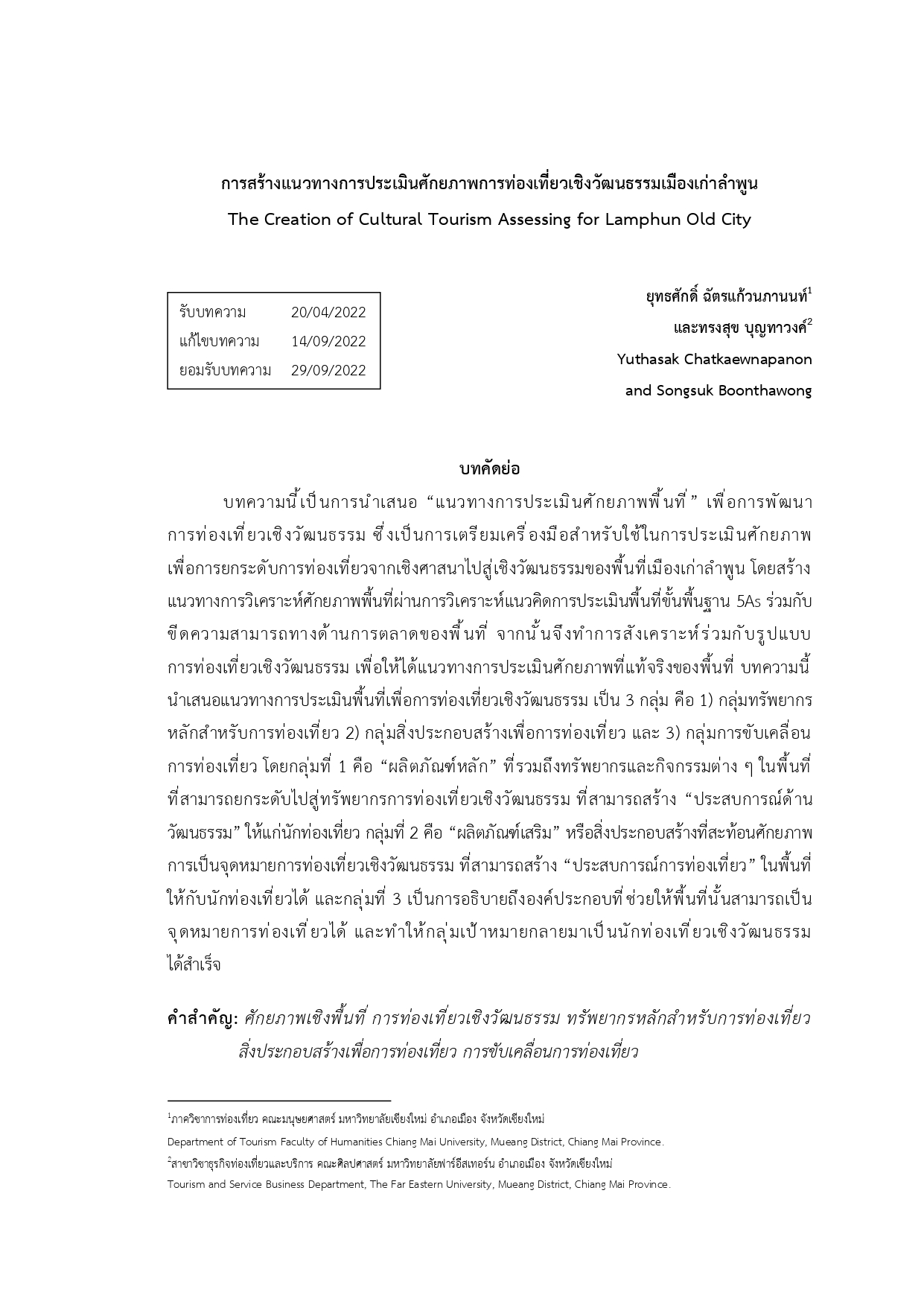The Creation of Cultural Tourism Assessing for Lamphun Old City
Keywords:
spatial potential, cultural tourism, cultural resource, tourism support, tourism makingAbstract
This article is a presentation “A guideline for assessing the potential of the area” for the development of cultural tourism. The aim is to prepare necessary tools for assessing the old Lamphun area, and to upgrading its religious tourism to cultural tourism. By creating a guideline for analyzing the potential of the area, the paper is based on the analysis of the basic 5As spatial potential assessment concept, coupled with the market capability of the area, then synthesizing with the cultural tourism approach. The paper proposes a guideline for assessing the area for cultural tourism within 3 categories: 1) Cultural resource 2) Tourism supporting and 3) Tourism making. The first group is the “core value”, which is cultural related products of the place that can create “cultural experience” to tourists. The second group is “Supporting Products” or structures that can creating “tourism experience” to tourists. The third group refers to factors that enable to turn a place into a tourist destination and importantly to turn target customers into cultural tourists.
References
จังหวัดลำพูน. (2561). ลำพูน-เสน่ห์แห่งล้านนา-"เมืองต้องห้าม"...พลาด. ค้นเมื่อ ธันวาคม 4, 2564, จาก http://www.lamphun.go.th
ชาญวิทย์ เกษตรศิริ. (2540). การท่องเที่ยวทางวัฒนธรรม. กรุงเทพฯ: สำนักงานกองทุนสนับสนุนการวิจัย.
เทศบาลเมืองลำพูน. (2560). เอกสารสรุปการพัฒนาเมืองเก่าลำพูน. ลำพูน: กองวิชาการและแผนงาน เทศบาลเมืองลำพูน.
บุญเลิศ จิตตั้งวัฒนา. (2555). การจัดการด้านการตลาดอุตสาหกรรมการท่องเที่ยว. นนทบุรี: พริ้นติ้งแอนด์พับลิชชิ่ง.
มิ่งสรรพ์ ขาวสะอาด และคมสัน สุริยะ. (2551). รายงานการวิจัยการพัฒนาการท่องเที่ยวเชิงบูรณาการที่ยั่งยืนในลุ่มแม่น้ำโขง. เชียงใหม่: สถาบันวิจัยสังคม มหาวิทยาลัยเชียงใหม่.
สรัสวดี อ๋องสกุล. (2554). ประวัติศาสตร์ล้านนา (พิมพ์ครั้งที่ 8). กรุงเทพฯ: อมรินทร์
สำนักงานคณะกรรมการวัฒนธรรมแห่งชาติ. (2535). วัฒนธรรมกับการเปลี่ยนแปลง. กรุงเทพฯ: สำนักงานคณะกรรมการวัฒนธรรมแห่งชาติ.
สำนักงานนโยบายและแผนทรัพยากรธรรมชาติและสิ่งแวดล้อม. (2553). แผนแม่บทและผังแม่บทการอนุรักษ์และพัฒนาบริเวณเมืองเก่าลำพูน. กรุงเทพฯ: กระทรวงทรัพยากรธรรมชาติและสิ่งแวดล้อม.
สุบัน พรเวียง และคณะ. (2560). รายงานการวิจัยการพัฒนาศักยภาพการท่องเที่ยวเชิงวัฒนธรรมอย่างยั่งยืนของชาวกะเหรี่ยงบ้านวุ้งกะสัง จังหวัดกำแพงเพชร. กรุงเทพฯ: กรมส่งเสริมวัฒนธรรม กระทรวงวัฒนธรรม.
ห้าวหาญ ทวีเส้ง และคณะ. (2563). ศักยภาพแหล่งท่องเที่ยวเชิงสร้างสรรค์จังหวัดสตูล. วารสารการบริการและการท่องเที่ยวไทย, 15 (1), 1-16.
Ageeva, E. & Foroudi, P. (2019). Tourists' destination image through regional tourism: From supply and demand sides perspectives. Journal of Business Research, 101, 334-348.
Armstrong, G. & Kotler, P. (2009). Marketing, an introduction (9th ed.). New Jersey: Pearson Prentice Hall.
Chatkaewnapanon, Y. (2012), A tourism history of Koh Samui: Change and adaptation in the tourism period. Saarbrucken: Lambert Academic Publishing.
Chatkaewnapanon, Y. et al. (2017). The place identity and the attractiveness of rural Thailand: An approach for sustainable tourism development of Mae Klang Luang in Northern Thailand. International Journal of Asian Social Science, 7 (9), 708-717.
Dickman, S. (1996). Tourism: An introductory text. Sydney: Hodder Education.
Kotler, P. (1997). Marketing management: analysis, planning implementation and control. (9th ed.). New Jersey: Asimmon & Schuster
Kotler, P. (2003). Marketing management (11th ed.). Upper Saddle River, NJ: Prentice Hall.
Fill, C. (1999). Marketing communications: Contexts, contents and strategies. (2nd Ed.). Barcelona, Spain: Prentice-Hall, Europe.
Formica, S. (2000). Destination attractiveness as a function of supply and demand interaction, Unpublished Doctoral Dissertation, the Virginia Polytechnic Institute and State University, Virginia.
Gardener, E. & Trivedi, M. (1998). A communications framework to evaluate sales promotion strategies. Journal of Advertising Research, 38, 67-71.
Hanpachern, R. & Chatkaewnapanon, Y. (2013). Understanding a tourist destination: tourism history approach. International Journal of asian social science, 3 (12), 2399-2408.
Hanpachern, R. & Chatkaewnapanon, Y. (2014). Managing tourism in the greater mekong region (GMS): A case study of Chiang Khan community, Northeast Thailand. Eurasian Journal of social science, 2 (1), 20-29.
Lovelock, C. & Wirtz, J. (2007). Services marketing people, technology. strategy.
(16th Ed.). New Jersey: Pearson Education.
Manhas, P. S., Manrai, L. A. & Manrai, A. K. (2016). Role of tourist destination development in building its brand image: A conceptual model. Journal of economics, finance and administrative science. Retrieved June 19, 2019, form http://dx.doi.org/10.1016/j.jefas.2016.01.001
Sommano, S. R. Suksathan, R, Wongnak, M. & Chatkaewnapanon, Y. (2017). Edible flowers in Northern Thailand (Rainy Season): from natural habitats, locally grown vegetables, to culture, food and tourism. Chiang Mai: RPP ALL.
Tangtenglam, S. et al. (2020). The possibility of Amazing Thailand Safety & Health Administration logo usage by tourism industry entrepreneurs in Southeast Asian Nations. Solid State Technology, 63 (5), 1354-1361.
UNWTO. (1997). Tourism 2020 vision. Madrid: UNWTO.

Downloads
Published
How to Cite
Issue
Section
License
Copyright (c) 2023 Journal of Humanities and Social Sciences Nakhon Pathom Rajabhat University

This work is licensed under a Creative Commons Attribution-NonCommercial-NoDerivatives 4.0 International License.
Journal of Humanities and Social Sciences Nakhon Pathom Rajabhat University





